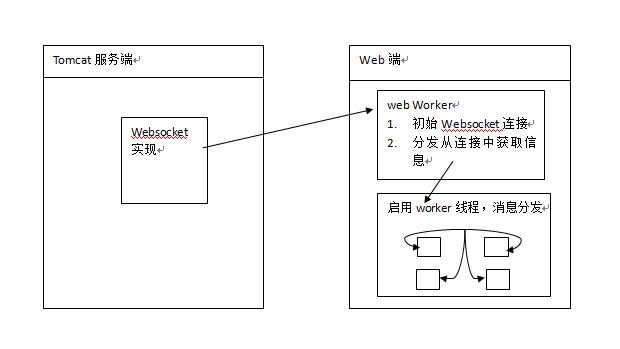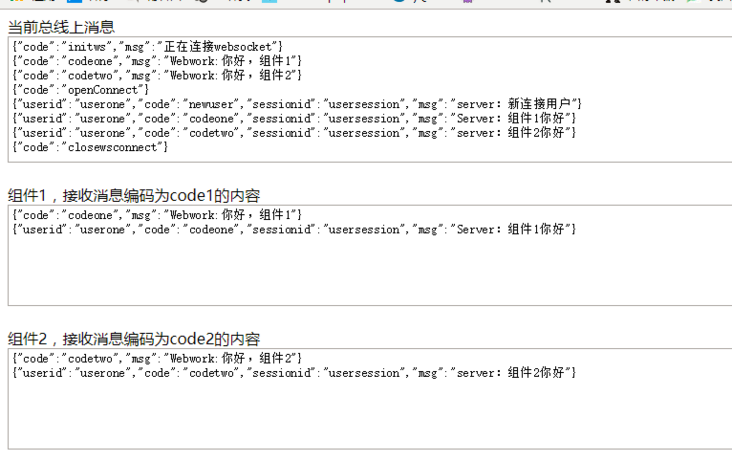WebWorker与WebSocket实现前端消息总线
2021-03-18 07:25
Web Worker让JS有了多线程的能力,可以将复杂耗时的操作都交付给Worker线程处理。WebSocket让web端与服务端维持一个有效的长连接,实现服务端主动推送数据。将二者一结合,业务系统信息流转通知功能完全就可以剥离出来。
架构图

JS Worker
Worker工作在一个专用的作用域DedicatedWorkerGlobalScope,在这个作用域中,不能直接操作DOM节点,不能使用Window对象的默认方法和属性。不过对于网络的访问是完全没有问题的。具体能使用那些对象和方法请点击这里查看
从上图中可明显的看出,Worker在当前架构中实现一个桥梁的左右,上连接socket端中的数据,下负责分发socket中的数据。此处我们先了解下Worker本身的功能实现。
- 主线程与Worker线程通过方法
postMessage相互传递信息 - 主线程与Worker线程通过事件
onmessage接收相互传递的消息 - Worker中引入第三方js使用方法
importScripts([url,]) - 主线程调用
worker.terminate()结束线程 - Worker线程通过调用
this.close()结束自身线程
新建一个webworker.js文件,并在其中编写如下代码
//author:herbert qq:464884492
onmessage = function (event) {
if (event.data.code) {
var code = event.data.code.toLowerCase();
switch (code) {
case "init":
var userId = event.data.loggedUserId;
var sessionId = event.data.sessionid;
if (!sessionId) {
this.close();
return;
}
postMessage({ code: "codeone", msg: "你好,组件1" });
postMessage({ code: "codetwo", msg: "你好,组件2" });
break;
default:
break;
}
}
}注意:在 onmessage 前不能加var否则在IE下会接收不了消息。IE真是让人充满挫败感的浏览器
新建一个index.html页面,在script块中编写以下代码,实现与webworker.js通讯
//author:herbert qq:464884492
var work = new Worker(‘webworker.js‘)
, textone = document.querySelector("#textone")
, textTwo = document.querySelector("#texttwo")
textAll = document.querySelector("#textAll");
work.onmessage = function (event) {
var data = event.data;
if (!!data.code) {
switch (data.code) {
case "close":
work.terminate();
case "codeone":
textone.value = textone.value + JSON.stringify(data) + "\r\n";
textAll.value = textAll.value + JSON.stringify(data) + "\r\n";
break;
case "codetwo":
textTwo.value = textTwo.value + JSON.stringify(data) + "\r\n";
textAll.value = textAll.value + JSON.stringify(data) + "\r\n";
break;
default:
textAll.value = textAll.value + JSON.stringify(data) + "\r\n";
}
}
};
work.postMessage({
code: "init",
loggedUserId: ‘demo‘,
sessionid: ‘demo‘
});JS WebSocket
WebSocket和Http一样都是基于Tcp协议。不同是WebSocket实现了服务端与客户端的全双工通讯。在Websocket未出现之前,要是实现一个信息推送的功能,通过http来实现唯一方案就是轮训,轮训分长短,各有弊端。现在WebSocket一出现,一切都好办了。
接下来我们开始建立一个WebSocket连接
方法中的root表示当前作用域,在主线程是root=window,在WebWorker线程root=DedicatedWorkerGlobalScope
//author:herbert qq:464884492
var root = this,socket =null;
function connect(wsurl) {
if (‘WebSocket‘ in root) {
socket = new WebSocket(wsurl);
} else if (‘MozWebSocket‘ in root) {
socket = new MozWebSocket(wsurl);
} else {
alert("您的浏览器版本过低,将不能接收系统消息");
}
}wsurl格式为 ws:\\ 或者 wss:\\,后者表示SSL加密传输。实际地址如: ws://localhost:8090/demo/demowebsocket
接下来,我们需要为socket处理事件,负责接收服务端推送的消息
//author:herbert qq:464884492
function onOpen() {
postMessage({ code: "openConnect" });
}
function onClose() {
postMessage({ code: "closewsconnect" });
}
function onMessaage(event) {
postMessage(JSON.parse(event.data));
}
function onError(event) {
socket = null;
if (event.target.readyState == 3) {
//断线重连
setTimeout(function () {
connect(event.target.url);
initMessageEvent();
}, 1000);
}
}
function sendMessage(msg) {
if (socket == null) return;
socket.send(msg);
}
function initMessageEvent() {
socket.onopen = onOpen; //socket连接成功处理事件
socket.onclose = onClose; //socket连接关闭处理事件
socket.onmessage = onMessaage; //socket接收到新消息
socket.onerror = onError; //soket错误处理事件
}JAVA WebSocket
Tomcat7x已经实现了标准WebScoket接口,在项目中只需要编写一个普通的实体bean配置注解就可以实现一个标准的WebSocket Api。开发中主要使用一些注解
- @ServerEndpoint 设置WebSocket连接地址,以及url参数
如: @ServerEndpoint(value = "/demowebsocket/{userId}/{sessionId}"),其中{userId}、{sessionId} 为pathParam可以在onOpen函数中通过函数参数 @PathParam 获取 - @PathParam 获取URL地址上对应的注解参数
- @OnOpen 建立连接注解
- @OnClose 关闭连接注解
- @OnMessage 接收消息注解
- @OnError 错误注解
被注解约束的函数都可以任意选择需要的参数,可选择的参数有 Session、EndpointConfig 以及 @PathParam, 服务端Bean代码如下
//author:herbert qq:464884492
@ServerEndpoint(value = "/demowebsocket/{userId}/{sessionId}")
public class DemoWebSokcet {
private static final Set connections = new CopyOnWriteArraySet();
private Session session;
public DemoWebSokcet() {
}
@OnOpen
public void openConnection(Session session, EndpointConfig conf,
@PathParam("userId") String userId,
@PathParam("sessionId") String sessionId) {
this.session = session;
connections.add(this);
JSONObject jo = new JSONObject();
jo.put("code", "newuser");
jo.put("userid", userId);
jo.put("sessionid", sessionId);
jo.put("msg", "server:新连接用户");
sendMessage(jo);
// 测试 代码
JSONObject jo1 = new JSONObject();
jo1.put("code", "codeone");
jo1.put("userid", userId);
jo1.put("sessionid", sessionId);
jo1.put("msg", "Server:组件1你好");
sendMessage(jo1);
JSONObject jo2 = new JSONObject();
jo2.put("code", "codetwo");
jo2.put("userid", userId);
jo2.put("sessionid", sessionId);
jo2.put("msg", "server:组件2你好");
sendMessage(jo2);
}
@OnClose
public void closeConnection(@PathParam("userId") String userId,
@PathParam("sessionId") String sessionId) {
connections.remove(this);
JSONObject jo = new JSONObject();
jo.put("code", "connectionClose");
jo.put("userid", userId);
jo.put("sessionid", sessionId);
jo.put("msg", "server:连接关闭");
sendMessage(jo);
}
// 处理文本消息
@OnMessage
public void handleTextMsg(Session session, String message,
@PathParam("userId") String userId,
@PathParam("sessionId") String sessionId) {
System.out.println("userId=>" + userId + " sessionId=>" + sessionId);
// 原样转发客户端消息
sendMessage(JSONObject.parseObject(message));
}
// 处理二进制消息
@OnMessage
public void handleBinaryMsg(Session session, ByteBuffer msg,
@PathParam("userId") String userId,
@PathParam("sessionId") String sessionId) {
}
// 处理pong消息
@OnMessage
public void handlePongMsg(Session session, PongMessage msg,
@PathParam("userId") String userId,
@PathParam("sessionId") String sessionId) {
JSONObject jo = new JSONObject();
jo.put("code", "pong");
jo.put("userid", userId);
jo.put("sessionid", sessionId);
jo.put("msg", msg.getApplicationData().toString());
sendMessage(jo);
}
@OnError
public void onError(Throwable t, @PathParam("userId") String userId,
@PathParam("sessionId") String sessionId) throws Throwable {
JSONObject jo = new JSONObject();
jo.put("code", "servererror");
jo.put("userid", userId);
jo.put("sessionid", userId);
jo.put("msg", t.getMessage());
sendMessage(jo);
}
private static void sendMessage(JSONObject msg) {
for (DemoWebSokcet client : connections) {
try {
synchronized (client) {
client.session.getBasicRemote()
.sendText(msg.toJSONString());
}
} catch (IOException e) {
JSONObject jo = new JSONObject();
jo.put("code", "servererror");
jo.put("userid",
client.session.getPathParameters().get("userid"));
jo.put("sessionid",
client.session.getPathParameters().get("sessionid"));
connections.remove(client);
try {
client.session.close();
} catch (IOException e1) {
}
jo.put("msg", "server:发送消息出现异常,连接已关闭" + e.getMessage());
sendMessage(jo);
}
}
}
} 在测试代码编写过程中,通过pom方式引入javax.websocket-api,启动后始终出现 Error during WebSocket handshake: Unexpected response code: 404连接错误,后来通过直接件tomcat/bin下对应的tomcat实现的jar复制到webapp对应的bin文件夹下解决问题。
Demo预览

总结
篇幅比较长,读到这里也不容易!WebWorker和WebSocket我也是第一次将二者结合起来。感觉现在javascript功能真的是越来越丰富了。demo地址,还有一点感悟,对于开发中的新知识点,首先你得学会怎么用,其次在通过阅读源码,以及理论知识让你使用的更顺利,甚至改变它。
文章标题:WebWorker与WebSocket实现前端消息总线
文章链接:http://soscw.com/index.php/essay/65677.html